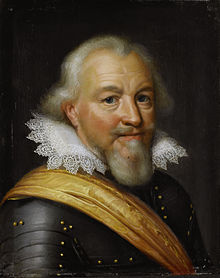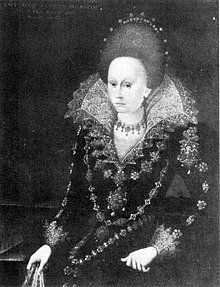Johann VII. (Nassau-Siegen)
Johann VII. Count of Nassau-Siegen , also Johann the Middle , (born June 7, 1561 in Dillenburg , † September 27, 1623 in Siegen ) was Count of Nassau-Siegen . His reign lasted from 1607 to 1623.
Life
Johann VII. Was the second son of Count Johann VI. von Nassau-Dillenburg (* 1536; † 1606) and Elisabeth von Leuchtenberg (* 1536/37; † 1579), daughter of Landgrave Georg III. from Leuchtenberg .
As a later son, he was chosen for a military career. He studied at the University of Heidelberg and then went on a cavalier tour to Italy, France and the Netherlands. Johann married Countess Magdalena von Waldeck (* 1558–1599), daughter of Count Philipp IV. Von Waldeck and widow of Count Philipp Ludwig I. von Hanau , on December 9, 1581 in Dillenburg Castle , the ancestral seat of the Ottonian line of the House of Nassau -Münzenberg . After the death of his first wife on August 27, 1603, he married Princess Margarethe of Schleswig-Holstein-Sonderburg (* 1583, † 1638), daughter of Duke Johann of Schleswig-Holstein-Sonderburg and niece of the Danish king.
Military achievements
Together with his father he carried out a military reform in Nassau, the Landesdefension , and later in the Netherlands, the Orange Army Reform . These included, among other things, general conscription , a new battle order, a new command structure, uniform armament and uniforms for the troops. All of this was completely new at the time. Count Johann VII. Is considered to be the author of the 1594/95 defense book for the county of Nassau . The script regulated the basic conditions of the new militia system. In Siegen in 1616 he founded the war school in the armory of the Upper Castle, probably the oldest military academy in the world.
Inheritance
When the estate was divided up with his brothers after his father's death in 1607, Johann VII was granted the state of Siegen with his residence in the city of Siegen, which made him the founder of the House of Nassau-Siegen . Johann VII lived there in the Upper Castle , he had the Lower Castle converted into a widow's residence for his wife.
The son John VIII the Younger , who was appointed as his successor in 1607, converted to the Roman Catholic Church in Rome in 1612 . In 1621, Johann VII ordered his country to be divided into three tribal parts in order to preserve the Reformed Confession. However, John VIII used the situation of the Thirty Years War to occupy the entire county of Nassau-Siegen and obtained an imperial mandate to legalize this.
Healthcare
The Count John VII., And Georg von Nassau-Beilstein agreed on April 5, 1615 after years of wrangling between the houses Nassau and Wied-Runkel on behalf of all Nassau rulers with Count Hermann von Runkel that the property of the monastery Beselich as Hospital under the direction intended to serve the Count of Nassau. The monastery life, which had meanwhile become difficult, was finally over there. The necessary hospital building was built as a rural hospital in 1618.
death
Count Johann VII died in Siegen at the age of 62. His final resting place is in the Siegener Fürstengruft next to the tomb of Johann Moritz .
progeny
John VII had the impressive number of 25 descendants; fourteen sons and eleven daughters from his two marriages. His marriage to Countess Magdalena von Waldeck (* 1558 - † 1599), daughter of Count Philipp IV. Von Waldeck and widow of Count Philipp Ludwig I. von Hanau-Münzenberg on December 9, 1581 resulted in the following twelve children:
- Johann Ernst (born October 21, 1582; † September 17, 1617 in Udine , fallen), Venetian general in the Friulian War
- John VIII (* 1583; † 1638), the younger
- Elisabeth (* 1584; † 1661), ⚭ 1604 Count Christian von Waldeck (* 1585; † 1637)
- Adolf (* 1586; † November 7, 1608 in Xanten , fallen)
- Juliane (* 1587; † 1643), ⚭ 1603 Landgrave Moritz von Hessen-Kassel (* 1572; † 1632)
- Anna Maria (* 1589; † 1620), ⚭ 1611 Count Johann Adolf von Daun-Falkenstein (* 1582; † 1623)
- Johann Albrecht (* 1590; † 1593)
- Wilhelm (* August 13, 1592; † July 18, 1642), ⚭ 1619 Countess Christine zu Erbach (* 1596; † 1646)
- Anna Johanna (* 1594; † 1636), ⚭ 1619 Johan Wolfert van Brederode (* 1599; † 1655)
- Friedrich Ludwig (* 1595; † 1600)
- Magdalena (* August 8, 1596; † December 19, 1661), ⚭ I) August 1631 Baron Bernhard Moritz von Oeynhausen (* 1602; † 1632), ⚭ II) August 25, 1642 Baron Philipp Wilhelm von Innhausen and Knyphausen (* 1591 ; † 1652)
- Johann Friedrich (* 1597; † 1597)
From his second marriage, which he had concluded on August 27, 1603 with Princess Margarethe of Schleswig-Holstein-Sonderburg (* 1583, † 1638), daughter of Duke Johann von Schleswig-Holstein-Sonderburg , the following thirteen children were born:
- Johann Moritz (* 1604; † 1679), called the Brazilian , Dutch field marshal, master master of the Order of St. John of the Brandenburg Ballot
- Georg Friedrich (* 1606; † 1674)
- Wilhelm Otto (born June 23, 1607; † August 14, 1641 in Wolfenbüttel, died)
- Louise Christina (1608–1685), ⚭ 1627 Philippe-François de Watteville, Marquis de Conflans (* 1605; † 1636)
- Sophia Margaretha (1610–1665), ⚭ 1656 Count Georg Ernst of Limburg-Styrum (* 1593; † 1661)
- Heinrich (* 1611; † 1652)
- Marie Juliane (1612–1665), ⚭ 1637 Duke Franz Heinrich of Saxony-Lauenburg (* 1604; † 1658)
- Amalie (1613–1669), ⚭ I) April 28, 1636 Hermann von Wrangel (* 1587; † 1643), ⚭ II) April 3, 1649 Count Palatine Christian August von Sulzbach (* 1622; † 1708)
- Bernhard (* 1614; † 1617)
- Christian (* July 16, 1616; † April 11, 1644 in Düren , fallen) ⚭ Anna Barbara Quad von Landskron
- Catharina (* 1617; † 1645)
- Johann Ernst II (* 1618; † 1639)
- Elisabeth Juliana (* 1620; † 1665), ⚭ 1647 Count Bernhard von Sayn-Wittgenstein-Berleburg (* 1620; † 1675)
literature
- Adriaan WE Dek: Count Johann the Middle of Nassau-Siegen and his 25 children. Self-published, Rijswijk 1962.
- Pierre Even : Luxembourg-Nassau dynasty. From the Counts of Nassau to the Grand Dukes of Luxembourg. A nine hundred year history of rulers in one hundred biographies. Schortgen, Luxemburg 2000, ISBN 2-87953-600-6 , pp. 120-122.
- Pierre Even: The House of Orange-Nassau. Up to the kings of the Netherlands (= German royal houses. H. 30). Börde-Verlag, Werl 2009, ISBN 978-3-9811993-6-9 , p. 22.
- Ernst Joachim: Johann the Middle of Nassau-Siegen . In: Allgemeine Deutsche Biographie (ADB). Volume 14, Duncker & Humblot, Leipzig 1881, p. 265 f.
- Rolf Glawischnig: Johann VII .. In: New German Biography (NDB). Volume 10, Duncker & Humblot, Berlin 1974, ISBN 3-428-00191-5 , p. 501 ( digitized version ).
- Werner Hahlweg : The army reform of the Orange. The war book of Count Johann von Nassau-Siegen (= publications of the Historical Commission for Nassau, 20). Edited by Werner Hahlweg and ed. from the Historical Commission for Nassau . Wiesbaden 1973.
Web links
Individual evidence
- ^ Even: The House of Orange-Nassau. 2009, p. 22.
- ^ Franz-Josef Sehr : 250 years pilgrimage chapel Maria Hilf Beselich . In: Yearbook for the Limburg-Weilburg district 2017 . The district committee of the district of Limburg-Weilburg, Limburg-Weilburg 2016, ISBN 3-927006-54-8 , p. 137-141 .
- ^ Adolf Müller: Milestones from the Siegerland past. In: Siegerland home calendar. Vol. 41, 1966, ZDB -ID 529717-5 , p. 96.
| predecessor | Office | successor |
|---|---|---|
| Johann VI. (Nassau-Dillenburg) |
Count of Nassau-Siegen 1607–1623 |
John VIII |
| personal data | |
|---|---|
| SURNAME | John VII |
| ALTERNATIVE NAMES | Johann VII. Count of Nassau-Siegen; Johann the Middle |
| BRIEF DESCRIPTION | Count of Nassau-Siegen |
| DATE OF BIRTH | June 7, 1561 |
| PLACE OF BIRTH | Dillenburg |
| DATE OF DEATH | September 27, 1623 |
| Place of death | Wins |


